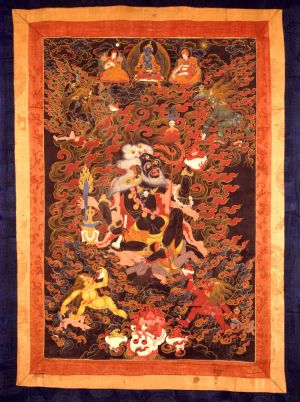The Buddhist deity Mahakala as a Brahman
Who is this deity?
Mahakala Bramanarupa is one of over 70 different deities of the Mahakala type.
These are wrathful deities particularly adept at quelling monsters and overcoming demons, whether they be outer, inner or secret. Some deities, such as Avalokiteshvara have their own Mahakala form.
Here Gonpo takes the guise of a brahman to appear in the world of ordinary beings. This Mahakala is from the Sakya Ngor Monastery located to the southwest of Lhasa where he is honored as one of their patron deities.
Brahman refers to the priestly caste in the traditional Hindu system, which stressed purity.
Although no longer accepted today, traditionally caste was linked to one’s skin color—the high caste brahmans had light skin, lower castes had dark skin.
The Buddha strongly objected to this concept, and stressed the importance of a person’s heart and mind over their external characteristics determined by birth.
In the Buddhist concept, you were of a high caste if you had pure altruistic motivation. You were of a low caste if you were harmful to others.
By showing a dark skinned brahman in such close proximity to corpses and other impurities, this manifestation of the deity aggressively confronts the racism of the traditional caste system, and conveys the message that one cannot be polluted by death or outward appearances. In Buddhism the only pollution rests within.
According to legend, in the thirteenth century, Phakpa (1235-80), the great lama of the Sakya order, went to Mongolia to convert Kublai Khan to Buddhism.
Actually he went as a hostage to the Mongol court to solidify Tibet’s surrender to the Mongols.
Kublai Khan already knew something about Buddhism and he questioned Phakpa on a particular text with which the lama was not familiar.
Phakpa stalled by asking if they could continue the conversation the next day.
That night, Gonpo appeared to him in this form (as Mahakala Brahmanarupa) and placed before Phakpa a copy of the text. Thus fortified with the answers, Phakpa was able to convert the Khan and won for Buddhism a powerful supporter.
Tibet’s surrender to the Mongols and Mongolian support of Tibetan Buddhism helped ensure the safety of Tibet from Mongolian invasion, which China was not spared (Kublai Khan proclaimed the Yuan dynasty in China in 1272).
As a result, this deity is especially revered by the Sakyapa Order and the Ngor Monastery, which is home to an important lineage of the Sakyapa.
This painting can be directly traced to the Ngor Monastery by an inscription on the back that states it was once stored in the “Zil-non House” of the monastery.
Discussion Points/Teaching Suggestions:
Why might a powerful deity like Mahakala take on an ordinary human form like Bramanarupa?
Why might a powerful emperor like Kublai Khan take on a pacifist religion like Buddhism?
Source
http://education.asianart.org/explore-resources/artwork/buddhist-deity-mahakala-brahman-1700-1800
